Robotics Education Journal
 06/14/2017
06/14/2017 Last summer, the FAA relaxed the regulations for becoming a drone pilot, making it much easier for hobbyists and enthusiast to get into the game. At the same time, the opportunity to fly drones professionally is growing rapidly, as more and more industries are using drones to collect data than ever before. According to Glassdoor, drone operators earn about $33,500 a year nationally, and more than $60,000 in metropolitan areas like DC -- making drone flying a new and attractive employment option. Since much of the work is contractual or seasonal, becoming a drone pilot can provide good supplemental income and work schedule flexibility -- with little training. But before you sign up for online drone piloting classes, here are a few things you should know about the industry according to Jonathan Rupprecht, Esq., an aviation attorney and FAA certificated commercial pilot & flight instructor at Rupprecht Law -- a firm that specializes in "helping individuals and businesses navigate drone law."
 06/13/2017
06/13/2017 The new AMAZON ROBOTICS CHALLENGE (ARC) 2017 will be held in conjunction with RoboCup 2017 and will task robots with enhanced pick & stow tasks. This challenge was formerly titled the Amazon Picking Challenge, held at ICRA 2015 and RoboCup 2016.
Amazon notes that notwithstanding advances in warehouse robots “…commercially viable automated picking in unstructured environments still remains a difficult challenge. It is our goal to strengthen the ties between the industrial and academic robotic communities and promote shared and open solutions to some of the big problems in unstructured automation.”
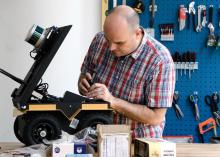 06/12/2017
06/12/2017 Paul Mozur and John Markoff of the NY Times reported late last month that China appears to be close to taking a lead in artificial intelligence (AI) research. Their outstanding report bears a revisit only two weeks into June, as the implications will reach many years into the future. Noted there: “It’s a race in the new generation of computing,” said James Lewis, a senior fellow at the Center for Strategic and International Studies. “The difference is that China seems to think it’s a race and America doesn’t.”
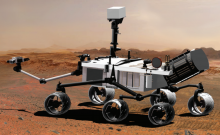 06/11/2017
06/11/2017 A recent poll conducted by Lockheed Martin suggests that few students show interest in space science that would point them toward a STEM-based career (Science, Technology, Engineering, Math) in space exploration. Only 23% of teachers polled agreed that current school curriculum are sufficiently preparing students for a career in space exploration.
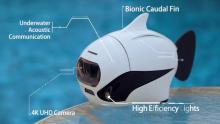 06/09/2017
06/09/2017 Able to dive to 196 feet, BIKI, the robot fish is programmable and returns to a previously determined GPS point on the surface. This exploratory robot has a 4K-capable sensor and 150 degree wide angle lens.
 06/06/2017
06/06/2017 A Russian drone flew to the top of Mount Everest. The unmanned aircraft achieved a world altitude record of 9333 meters, according to the Guinness Book of World Records. Russian company “Sistema Ramp” took credit for the achievement. The unmanned aircraft, named SKAT 640 4G TERRA, flew over the Himalayas in unforgiving, harsh climatic conditions. The drone was a flying wing, one of our favorite planforms.
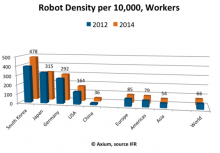 06/01/2017
06/01/2017 Robot density per 10,000 people in some of the better-known countries is shown here in a graphic recently published by Asian Robotics Review.
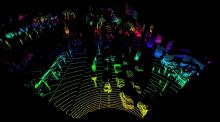 05/25/2017
05/25/2017 The NY Times published a story titled “What Self-Driving Cars See,” today, that includes a captivating video from which this image derives. Such systems see in near-infrared light. Intense development of the technology is underway, not to mention litigation in California between Uber and Waymo (run by Alphabet, Google’s parent).
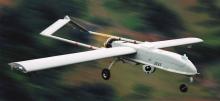 05/22/2017
05/22/2017 Echodyne announced a $29M Series B round to scale its technology for drones, autonomous vehicles, on-the-ground detection and more. To date, the best radar technology has been used almost exclusively in the military (phased array radars) because it costs hundreds-of-thousands of dollars. Echodyne has developed metamaterials to build high performance, high resolution radar at low cost. The small UAV shown is a suitable vehicle for the new radar and underscores the small size of Echodyne’s units.
 05/22/2017
05/22/2017 Sandra Helsel of RoboUniverse News has reported that the Softbank-Saudi tech fund backed by Japan’s Softbank Group and the Saudi Arabian sovereign wealth fund has more than $93 billion in investment funding for development of key emerging technologies such as artificial intelligence (AI) and robotics.
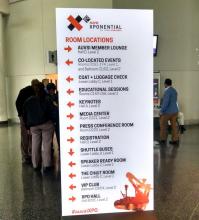 05/17/2017
05/17/2017 The annual AUVSI (Association for Unmanned Systems International) conference, titled Xponential 2017, with 600+ exhibitors from the U.S. and abroad, was the largest gathering of robotics businesses in U.S. history. Exhibitors included programmers, hardware manufacturers, consultants, academic institutions, application specialists, military providers and more. NREF will bring you our take on the most interesting exhibits in an upcoming report. As a teaser, check out three exciting new offerings: HitecRCD’s new industrial actuators, Rajant’s free-forming “kinetic Mesch” UAV network, and several views of a new Boeing unmanned helicopter.
 05/04/2017
05/04/2017 A new military computer hub reflects advanced hardware design and embodies latest standards. MILTECH 303 is a rugged USB3.1 hub with robust power management and charging. It provides connectivity between USB 3.0 devices like handheld phones, night vision goggles, and GPS devices and is also a robust charging tool that can accept 12 – 28VDC at up to 2A, as well as work with the most widely used charging profiles. It is smaller than a credit card and weighs under 5 oz.
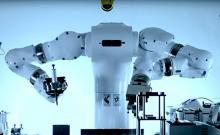 04/25/2017
04/25/2017 A leading robotics automation news portal that we very highly recommend is Asian Robotics Review, curated by veteran robotics and computer journalist Tom Green. His just reported summary of April 2017 robotics news from the accelerating crucible of technical innovation in Asia is a must-read. In this latest report, Tom focuses on life sciences technology and the 2-armed Maholo humanoid robots introduced by Japanese firm Robotic Biology Institute. Their innovative 2-armed humanoids target a trillion+ dollar industry that is now exploding in size.
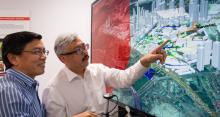 04/23/2017
04/23/2017 Singapore’s small airspace and concentrated population make an air traffic control (ATC) system for drones highly desirable to ensure safety and effective use of drone technology. Singapore’s respected Nanyang Technological University, an institution renowned for its expertise in autonomous vehicles and robotics, is at the center of the ATC project.
NTU Professor Low Kin Huat (left) and Air Traffic Management Research Institute’s Deputy Director Mr Mohamed Faisal Bin Mohamed Salleh discussing an NTU-developed air traffic simulation, which takes into account various solutions to enable safe and efficient drone travel in Singapore. Credit: NTU Singapore
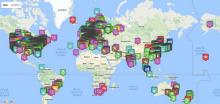 04/18/2017
04/18/2017 Of the half dozen or so top robotics sites in the English language, in terms of frequency of updates and value of the information, it is our considered opinion that Frank Tobe's TheRobotReport.com (TRR) is very near the top. From time to time we post an outline of the most recent news posted at TRR owing to the value of Frank's insightful reporting. From the impact of robotics on jobs and the latest in collaborative robotics to the future of automated farming (and more!), check out today's posting at TRR by clicking here:
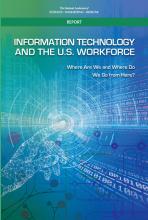 04/16/2017
04/16/2017 A new study from the National Academies of Sciences, Engineering and Medicine (NASEM) poses the question, and then suggest policymakers are not sufficiently attending to the important questions that arise in a projected future in which automation replaces human workers at a growing pace.
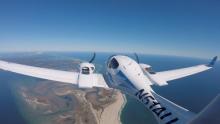 04/13/2017
04/13/2017 Aroura Flight Sciences Centaur optionally piloted aircraft is proving to be a key tool in the new airborne gravity survey campaign for the National Oceanic and Atmospheric Administration (NOAA). Under the current survey, Aurora is collecting gravity data in a region of North Carolina to fulfill NOAA’s GRAV-D program needs and to fill gaps in the existing data sets used to define the U.S. vertical datum, the company says. Through the GRAV-D program, Centaur’s data is helping increase the accuracy of elevation measurements to determine where water will flow – which is instrumental for scientists, urban planners, agriculture and construction industries, and flood control managers, according to Aurora.
 04/10/2017
04/10/2017 UAS applications are proliferating across many industries and markets, nationally and globally. Differences in approaches to implementation of UAS and in the regulation of drones are likely because the UAS business is racing forward with indepedent decisions being made on a local level. Municipal governing bodies answer to their local constituencies and need to empower local authorities (police) to ensure safe UAS use. Whether state laws or federal regulation might eventually preempt this patchwork quilt of local municipal regulation is an open question.
 03/29/2017
03/29/2017 Turning switches on and off, speaking in sign language and other useful applications based on hand gestures will likely emerge owing to this new technology.
 03/28/2017
03/28/2017 Drone expert and attorney Jonathan Rupprecht has posted a guide to safe and legal flying of drones for the wide variety of participants in this industry, from hobbyists to business owners to governmental regulators. This outline with its drill-down linked resources is a real gem and not to be missed!
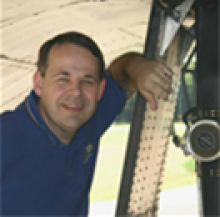 03/26/2017
03/26/2017 The question of how to defend against hostile drones is of growing importance. “Counter UAS technology seeks to detect, identify, and neutralize aggressive UAS.” This free webinar will address control-override, communication interference and other methods of interdicting UAS.
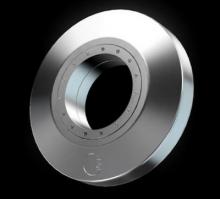 03/25/2017
03/25/2017 These are not traditional rotational servos with gearboxes or linear actuators, but they could replace most traditional actuators in the robots of the future. The LiveDrive offers high torque-to-weight and low inertia, and very low stop times.
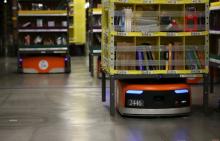 03/16/2017
03/16/2017 The NYTimes takes a comprehensive look at an area apparently largely ignored by politicians and the media, but it is one that will likely deeply impact how we live and earn a gainful living. The article has a significant running sidebar of commentary from thoughtful citizens. Of course, robotics has a central position in these coming changes.
 03/11/2017
03/11/2017 A drone that described as “both stiff and squishy” has the ability to survive crashes that would leave many similar-size craft inert. JC Torres of Slashgear.com reports that researchers from the École Polytechnique Fédérale de Lausanne, or EPFL, in Switzerland have designed and tested a prototype that was inspired by mother nature.

